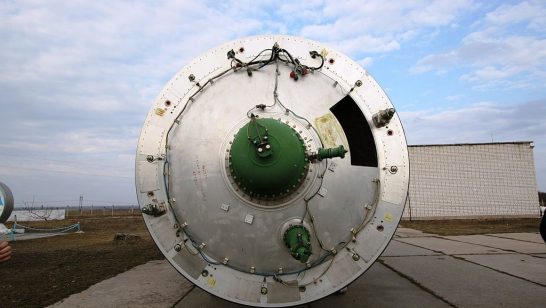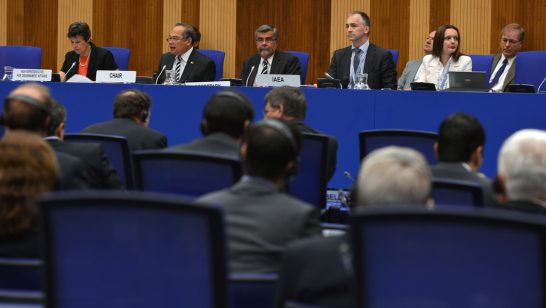
There’s something seriously fishy going on in international politics if even such a seemingly innocent initiative as setting up the International Day for the Total Elimination of Nuclear Weapons on September 26th ends in acrimony. Yet, this is exactly what happened a year ago when the proposal was included in a broader resolution focusing on nuclear disarmament, submitted to the UN by the Non-Aligned Movement. As some unconvinced UN members pointed out, the resolution’s focus on the need to speed up on the road to nuclear zero was ill-advised, as the conditions necessary for making further cuts to nuclear arsenals, including dealing with proliferation threats, were not even mentioned. Equally questionable for them was the added value of declaring yet another commemorative day related to disarmament. Predictably, the resolution prevailed in the General Assembly with the support of China, India and Pakistan, despite the fact that none of these countries are actively engaged in nuclear disarmament. However, among the 28 states who voted “no” were the United States, Russia, France, UK, Israel, Australia and a majority of NATO states. In case you’re wondering, North Korea voted in favour.
This episode captures the crux of the problem connected with pursuing nuclear disarmament. While no state openly questions the wisdom of global zero, the gap between the idealistic disarmers and the nuclear realists is widening. Moreover, with the Obama administration’s nuclear weapons policy no longer guided by the revolutionary spirit of the Prague speech, there is a notable lack of international leadership.
It is rather natural in this context for the disarmers, backed by a vibrant civil society movement, to start looking for ways to by-pass the stumbling blocks of the obstructionism of the nuclear weapon states and paralysis of traditional disarmament apparatus. Beginning preparation of an international convention banning nuclear weapons, or at least prohibiting their use, is the emblematic policy of the movement, and raising public awareness through today’s commemoration may help to publicize the cause.
Still, despite this laudable agenda, I’m worried about the dangers of creating something which amounts to a parallel world, in which “deterrence” is a dirty word, security concerns of nuclear weapon states and their allies can be disregarded, and total elimination of nuclear weapons can be achieved by adopting treaties without the presence of the main nuclear protagonists. Living in such a parallel universe can be comfortable and ethically rewarding. But this framework, sadly, does not help much in addressing the danger of a nuclear war and nuclear arms races in the 21st Century.
Instead of building the sand castle of a nuclear weapon convention draft, we need ideas that do not accept the division of the world among idealist disarmers and nuclear realists but rather fashion an agenda that realist disarmers can get behind. It is too little noted that while all nuclear weapon states continue modernization of their nuclear arsenals, this process is in some cases actually linked with a noticeable decrease of the numbers of warheads and delivery systems. This may not be ‘real’ disarmament, but it is to be welcomed.
Moreover, attention can and should be given to countering worrying trends which can make nuclear use or nuclear proliferation more likely in the months to come. Three challenges especially need to be urgently addressed:
1. Growing perceptions of an increased value of nuclear weapons. In a time of crisis in the international system, nuclear weapons may offer for several countries a tempting way out of national security predicaments. In the context of the Ukraine crisis, many Ukrainians bitterly complain that giving up nuclear weapons in the early 1990s in exchange for security guarantees did not shield their country from a Russian invasion. In other parts of the world, particularly Asia, an increasingly popular mantra – for example in South Korean opinion polls – states that only the ownership of nuclear weapons guarantees survival, especially if one is surrounded by nuclear armed states. Notably, both Russia and the U.S. have recently reiterated the centrality of nuclear weapons and nuclear deterrence in their security doctrines. As a consequence, the attractiveness of nuclear weapons seems to be on the rise, and it can be significantly decreased only if the stability of the international system as such is re-established.
2. The spectre of a “limited” nuclear war. Equally worrisome, some states have been developing both the nuclear weaponry and the doctrine for nuclear weapon use on the battlefield, to strike particularly valuable targets or to stop a conventional attack by an opponent. One can point to Pakistani development of short-range ballistic and cruise missiles to counter a possible Indian incursion, Russian plans for deployment of their non-strategic nuclear weapons in ‘de-escalation’ strikes, or speculations that China may target U.S. aircraft carrier groups with nuclear-tipped missiles. Lowering the nuclear threshold obviously increases the potential for miscalculation or losing control over escalation during a crisis. More generally, it also legitimises the nuclear weapons as a “rational” response to a conventional forces imbalance, despite the almost-assured perspective of a catastrophic nuclear exchange that would follow the first attack. Exposing the dangerous delusion of ‘battlefield-only’ nuclear weapons should be a priority, especially since even a single low-yield detonation would have disastrous political, humanitarian and environmental consequences.
3. The looming threat of NPT collapse. The state of the nuclear non-proliferation and disarmament regime is being measured in five-year intervals via the NPT Review Conference process, which means it mirrors the broader international dynamics of any particular period. The 2010 Conference thus reflected a renewed sense of optimism that the Obama administration had both the willingness and resources to reach progress on the disarmament and non-proliferation agenda, as well as to help facilitate forward-movement on the Middle Eastern WMD free zone. Since progress on at least two of these fronts is unlikely to be good enough for a majority of NPT members, the chances of having a productive NPT Review Conference meeting in April 2015 are close to zero (unless the NPT is given a boost by a positive development such as a nuclear deal with Iran). A failed Review Conference would not be a catastrophe in itself. However, some members may consequently be tempted to withdraw from the Treaty as a way to demonstrate their frustration with the glacial pace of fulfilling nuclear disarmament obligations – and the nuclear weapon states may be neither willing nor able to put more pledges on the table to stem the withdrawals. It would be a strange irony of history if the NPT collapsed not over North Korean or Iranian non-compliance, but due to such a ‘backbench revolt’ among the Non-Nuclear Weapon States. The question for anyone advocating such a shock therapy for the NPT is of course whether the breakdown of the regime would ultimately make the vision of a nuclear weapon free world more – or less – likely to be fulfilled. Still, this remains a plausible scenario for which especially the European Union should be prepared. As a club bringing together nuclear and non-nuclear countries, it can step in to offer proposals which may be acceptable to both sides of the divide.
In current international circumstances, the goal of the total elimination of nuclear weapons deserves to be taken seriously. That requires engaging, and not snubbing, the countries that actually possess them, and starting with the issues which are most threatening to us all.
The opinions articulated above represent the views of the author(s), and do not necessarily reflect the position of the European Leadership Network or any of its members. The ELN’s aim is to encourage debates that will help develop Europe’s capacity to address the pressing foreign, defence, and security challenges of our time.



